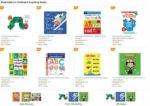self-publishing
now browsing by tag
Market Research for Authors Who Want to Improve Their Sales

Today, we’re going to take a moment to acknowledge that all of us are not having the book sales that we thought we would. We are not selling as many books as we hoped and dreamed. No matter where you are in the publishing process, it is possible to start fresh and begin promoting and selling more copies of your books. The best part is that you can do this in as little as 24 hours by doing just a few simple things.
We are going to start by doing some very basic marketing exercises. First, we are going to identify the top books in your genre as well as the top authors. That’s because you are going to use that list to go find your target readers. By knowing the bestselling authors in your genre, you’ll also be able to look into what they are doing to sell to their target audience.
If you’ve written a fantastic book that was meant to be read to a five-year-old, I promise you that they have a book basket that’s already stuffed with favorite books. Do you know who wrote those books? Do you know the names of the books that are on the bedside tables of children everywhere? What are the bestselling books in your genre today? How do you find that out? These are the types of topics we will be going over throughout this article.
We’ll be talking about how to research the bestselling books in your genre. Again, you’ll be gathering a long list of comparable and competitive titles so that we know where our readers are and what they are buying. One of the easiest ways to find your readers, once you know what the books are, is to see who lists these books, both on Amazon and Goodreads.
Comp Title Research
I did some research for a student of mine, named Heather, who thought her book was comparable to Goodnight Moon. Let’s say that this was your book. You could begin your research by heading over to Amazon and looking that book up. Now, let’s say that your book is available in both paperback and as a hardcover. You find that the hardcover version of Goodnight Moon is $18.99, and it’s in the “Classics” subcategory. Unfortunately, that’s not a category that will work for your “new” book. So, it’s time to search onward.
Now, let’s say that your book is not only a bedtime book for little kids, it’s also a counting book too. Since that’s the case, you might move on in your research to look up “counting books”. I did this and “counting books for toddlers” came up, which was perfect for the type of book we are researching. Once your search results appear, you should see some search filters over on the left-hand side of the screen, which you may want to use to be more specific in your research.
Upon doing this research myself, I narrowed my search down by choosing the subcategory “Children’s Counting Books” and the filter for hardcovers. The first book to come up was Goodnight Numbers, by Danica McKellar. It had 155 reviews, and the hardcover was priced at $16.99. When I clicked on the book and scrolled down the book’s sales page to the “Product Details” section, I found that it was listed under Children’s Books > Early Learning > Basic Concepts > Counting.
I clicked on the word “counting” in this category list, within the Product Details section, and I was redirected to that category. The page showed me all of the bestseller in that category.

The very top book listed was an Eric Carle book, The Very Hungry Caterpillar. I would like to take a moment to warn everyone against going after the classics. Trying to compare yourself to Eric Carle as a children’s book writer would be like writing a horror novel and compare yourself to Stephen King. That’s just not an apples to apples comparison. Your book might be comparable to Numbers Colors Shapes by Rodger Priddy, however.
How to Go Further
At this point, Heather felt like we were closing in on books that were much more similar to hers. Another book that came up in my search was Happy Easter Mouse, which is by Laura Numeroff. That’s the same author that wrote If You Give a Mouse a Cookie. Doggies, by Sandra Boynton, is another one that came up. This author is very famous. There was also Counting with Frida, by Patty Rodriguez. You might have to go through a number of these books to find a half a dozen or more books that are comparable to your own. One that I thought was a great example was How Do Dinosaurs Count to Ten? This book is written by Jane Yolen.
If you thought that this book would be one which your readers would like to read as well, and it’s not written by an author so famous that you could never keep up, then it would be a good book for you to research. When you reach the listing page, for the book you are researching, be sure to also look at the “Customers who bought this item also bought” section, just to see what else is there.
Now, Jane Yolen is very popular, so a lot of her books were in this section. There were also quite a few other dinosaur books for children. There weren’t any comparable counting books, really. So, I continued looking at the bestsellers in the “counting” subcategory. Next, I looked at Twenty Yawns by Jane Smiley. This book’s description boasts that it is a Huffington Post Best Children’s Book of the Year, and at the time this research was done, it had 796 reviews.
This is a terrific book, and it’s one that the readers of your books would probably have on their bedside table. Again, that’s if you were publishing a children’s counting book that’s meant to be read at bedtime. Of course, if your book is different, you would want to find books that are comparable to your own. They can’t be books that are phenomenally famous, but they should be books that are selling well that you are pretty sure are sitting on the bedside table of those people in your target audience. I recommend finding about 12 different books that fit this description.
Don’t Just Settle for Online Research!!!!!
When you are done with this Amazon research, I recommend that you get in your car and drive to the nearest library and the nearest bookstore. Tell the librarians and bookstore employees about your book, let them know what books you would compare it to, and tell them that you are looking for other books that are checked out a lot, or are bought a lot, that are comparable to yours. Get their opinions as well. Don’t just depend on Amazon.
Librarians are often lovely people, as are bookstore clerks in many cases. Tell them that you are an author doing market research. Let them know about the books you’ve already found and ask them to help you find books to add. They will probably be excited to help you, if they aren’t super-busy, that is. Before you know it, you’ll have a list full of books that you can look at further to help you in your own marketing.
I only chose the picture books that were also counting books because they were the most like Heather’s. Hopefully, I gave her enough ideas to start doing this research on her own, and I would encourage you to do the same. This is the initial research that you should do, but there’s far more to be done. We will continue on in future articles by discussing what you can do once you have gathered a list of the top authors and books in your genre.
POD Math

 A number of you have asked me about how the math works when you go to IngramSpark for POD. Here is an example:
A number of you have asked me about how the math works when you go to IngramSpark for POD. Here is an example:
A 204 page POD paperback book costs $4.98 to print. (.02 a page plus .90 for the cover)
The book is priced retail at 16.99
Ingram will purchase the book from Ingram Spark at 55% discount off of the retail price. That will leave you $7.65
Ingram Spark will take the $4.98 out of that total due for the printing and send you $2.67.
Ingram will then take the book that they bought from you (through Ingram Spark) and sell it to bookstores and libraries at a discount of anywhere from 20% – 42%.
You make $7.65 but have to pay for printing out of that.
Ingram Spark makes $4.98 for printing
Ingram Wholesalers make $2.21 – 5.95 but they have to pay for shipping and handling out of that. (FYI-If you choose the short discount and only let Ingram offer a 20% discount, you are severely limiting the number of places that will take your book….)
The bookstores and libraries make between $3.40 – $7.13 but they have to pay for employees, rent, lights and the rest out of that.
Does that make more sense?
A number of authors have questioned why they only get to “net” $2 or less in some cases. I would argue that once the stores and wholesalers pay THEIR expenses, they make a LOT LESS than that!
As long as you are making 11% of the retail price as a net before taxes, you are in good shape! (most established publishers would be thrilled with that)






 D5 Creation
D5 Creation